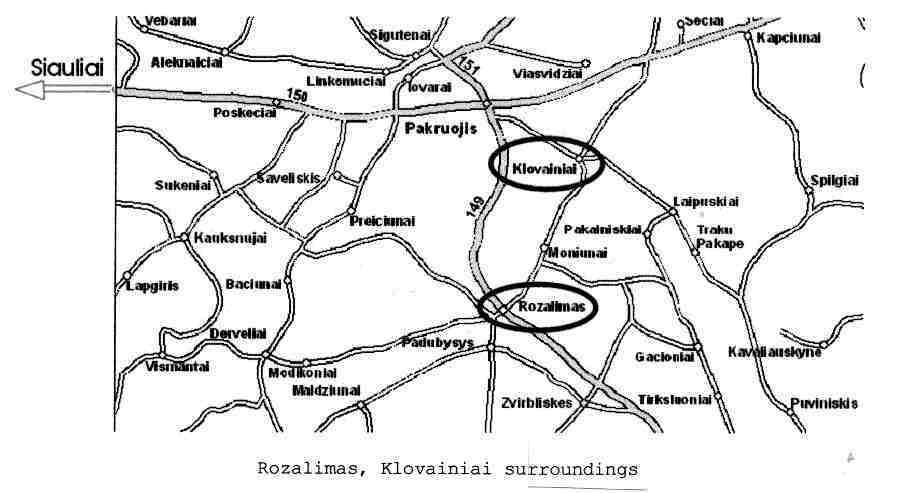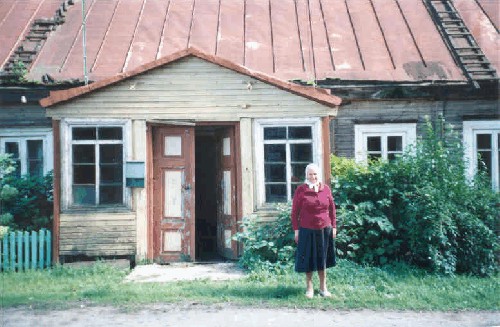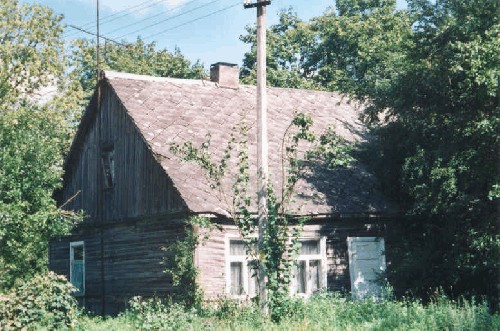Klovainiai
A
walk through Jewish Klovainiai, the way it was a few years before 1941.
Chapters: 1 2 3 stories from: Elzbieta Stefa
chapter 1

Klovainiai (‘Klovian’ in Yiddish) is a neighbouring village of Rozalimas. In Part I, I have told you about the Jewish men of Klovainiai who were shot in the forest of Rozalimas during the summer of 1941. In this part I shall tell you more about this atrocious event in detail. With the help from our dearest friend Birute Maiksteniene, our guide and interpreter, and one local eye-witness Emilija Mikolaitiene, we could find out more about the Jewish presence in Klovainiai some years before the big tragedy of 4-8-1941.
 Emilija
Mikolaitiene in front of her house
Emilija
Mikolaitiene in front of her house
I
presume that the Jewish families of Klovainiai were in the company of the Jewish
families of Rozalimas on a regular basis and vica versa. In Rozalimas stood a
synagogue, and on Shabbath (and on other special religious days) the Jewish
families of Klovainiai must have attended the services held there. Their
children must have gone to the Jewish school in Rozalimas. The rabbi of the
Jewish community of Rozalimas must have been the rabbi of the Jewish community
of Klovainiai too. No-one told me about this, but according to the facts we have
gathered I believe this to be the way it was back then.
The
Jewish men of Klovainiai were either traders or shopkeepers. No Jewish families
from either Rozalimas or Kloviainiai were related, but they certainly met and
spoke with one another.
Let’s start our walk through Jewish Klovainiai, and let’s see if we can find some information about the Jewish families who used to live there.
 wooden house
wooden house
At
the beginning of the Pušalotasgatve, on the left, we see a wooden house. The
house was divided into two parts; for three Jewish people to live in. In one
part of the house lived a Jewish family called ‘Chaike’, a mother and
daughter who earned a living by baking and selling all kinds of bread. One can
see that part of the house they used to live in very clearly in the picture. In
the other part of the house lived a Jewish man called ‘Motkes’, who earned a
living by slaughtering calves and selling the meat afterwards.
Continuing our walk through the Pušalotasgatve we stop in the middle of the gatve and see the Roman- Catholic church at a short distance from were we are standing. This church is on the left hand side.
 Kaimukas'
house
Kaimukas'
house
On
our right we see a yellow wooden house. It belonged to
Kaimukas, a shopkeeper.
He married Irshkis’ sister, whom I mentioned before in Part I, and Kaimukas
and his wife had two daughters. One of their daughters,
Merinka (‘Marite’ in
Lithuanian), was a student of Stefa who taught her how to knit in 1939. Nowadays
this address is called ‘Pušalotasgatve 10’.
The Lithuanian family presently living there told us that their father bought the house from the Soviet -State in 1951. Their father tried to save Kaimukas from the German Nazis in 1941 and took Kaimukas with him on his horse, but he didn’t know where to take him and eventually brought him back home. Later on I will tell you the end of this story.